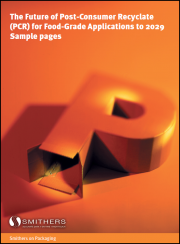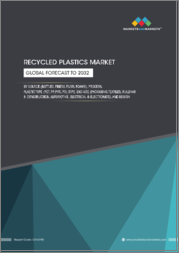
|
시장보고서
상품코드
1679791
식품용 PCR의 미래(-2029년)The Future of PCR for Food-grade Applications to 2029 |
||||||
주요 사실
- 2024년 전 세계 식품용 PCR 포장 소비량은 120만 톤을 넘어섰습니다.
- 2019년부터 2024년까지 시장 물량의 연간 성장률은 평균 9% 이상이며, 이는 식품 및 음료와 같은 최종 용도 부문의 강력한 수요와 플라스틱 포장재 제조에 있어 재활용 재료의 사용에 대한 강조로 인한 것입니다.
세계 플라스틱 포장 산업에서 식품용 PCR에 대한 수요는 지속적으로 증가하고 있으며, 포장재 내 재활용 재료의 양을 늘려야 한다는 압력이 증가하고 있습니다. 지금까지 플라스틱 포장에 식품용 PCR의 채택은 가용성 및 재료의 품질에 대한 우려 등의 요인으로 인해 제한되어 왔습니다.
소비 후 재활용(PCR)은 가정이나 상업시설에서 발생하여 소각이나 매립되지 않고 새로운 제품으로 재활용되는 물질을 말합니다. 포장 산업의 예로는 식수 PET 병 및 기타 식품 접촉 플라스틱이 있습니다. 식품용 PCR은 식품 및 음료 포장에 재사용하기 위해 조달, 가공 및 오염을 제거한 수지입니다. 투입된 재료는 식품과 접촉하여 재사용할 수 있는 인증을 받기 위해 규정된 규제 사양과 적정 제조 규범을 충족해야 합니다.
세계의 식품용 PCR 시장에 대해 조사 분석했으며, 기술 개발, 성장 촉진요인 및 동향, 버진 소재와의 비교 등의 정보를 전해드립니다.
목차
주요 요약
서론과 조사 방법
주요 시장 성장 촉진요인과 동향
- 서론
- 규칙
- 유럽
- 미국
- 기타 국가
- PCR 재활용 비용
- 장벽
- 장려책
- 이익
- 인구 증가
- 플라스틱 폐기물 증가
- 플라스틱 폐기물 재활용 비율
- 지속가능성에 대한 우려
기술 개발
- 서론
- 선별 및 세정
- 분류
- 폐기물원
- 세정
- 제염
- 선택 프로세스
- 신기술
- 케미컬 재활용
- 기타 재활용 시스템
- 메커니컬 재활용
- 주요 기업
- 개요
- 케미컬 재활용
- 정유소 재활용 시스템
- 메커니컬 재활용
- 탈황
식품용 PCR 시장 : 폴리머 유형별
- 개요
- 폴리에틸렌 테레프탈레이트(PET)
- 폴리에틸렌(PE)
- 저밀도 폴리에틸렌(LDPE)
- 고밀도 폴리에틸렌(HDPE)
- 선형 저밀도 폴리에틸렌(LLDPE)
- 에틸렌계 폴리올레핀 엘라스토머(POE)
- 폴리프로필렌(PP)
- 폴리스티렌(PS)
- 폴리염화비닐(PVC)
- 발포 폴리스티렌(EPS)
- 기타(COC, PA, EVA, EVOH, EPP, PVOH)
- 환형 올레핀 공중합체(COC)
- 폴리아미드(PA)
- 에틸렌초산비닐(EVA)
- 에틸렌 비닐 알코올(EVOH)
- 발포 폴리프로필렌(EPP)
- 폴리비닐 알코올(PVOH)
식품용 PCR 시장 : 최종 용도별
- 개요
- 식품
- 음료
- 의료
- 화장품
- 기타 소비자
식품용 PCR 시장 : 지역별
- 개요
- 유럽
- 북미
- 아시아태평양
- 기타 지역
- 중남미
- 중동 및 아프리카
Key facts:
- In 2024, global consumption of food-grade PCR packaging amounted to more than 1.2 million tonnes
- Between 2019 and 2024, annual growth in market volume averaged more than 9%, driven by strong demand in end-use sectors such as food and drinks, as well as greater emphasis on the use of recycled material in the manufacture of plastics packaging.
Global demand for food-grade PCR within the plastics packaging industry continues to grow, with more pressure on businesses to increase the amount of recycled material within their packaging. To date, adoption of food-grade PCR in plastics packaging has been limited by factors such as availability and concerns over the quality of the material.
Post-consumer recyclate (PCR) is defined as materials generated by household or commercial facilities, which have been recycled into new products instead of being incinerated or sent to landfill. Examples from the packaging industry include PET beverage bottles, and other food contact plastics. Food-grade PCR are resins that have been sourced, processed and decontaminated for re-use in food and beverage packaging. The input materials must meet defined regulatory specifications and good manufacturing practices, to achieve certification for re-use in contact with food.
Key Questions:
- How will the latest, more wide-ranging PCR requirements, including those set by the PPWR, impact food-grade PCR supply?
- How will the latest technology, including automated sorting and the arrival of commercial-scale chemical (advanced) recycling, transform the market over the next five years?
- How will PCR materials perform, compared to virgin resins, when converted into a new generation of food and beverage packs?
- How will the price of food-grade PCR perform relative to virgin resins?
This report is essential to:
- Packaging raw material suppliers
- Packaging converters and manufacturers
- Retailers and brand owners
Table of Contents
Executive summary
Introduction and methodology
- Introduction
- Methodology
- Definitions and abbreviations
- Polymer types
- End-use markets
- Geographic regions
Key market drivers and trends
- Introduction
- Regulations
- Europe
- US
- Other countries
- Costs of PCR recycling
- Barriers
- Incentives
- Profits
- Population growth
- Growth of plastic waste
- Plastic waste recycling rates
- Sustainability concerns
Technology developments
- Introduction
- Sorting and washing
- Sorting
- Waste sources
- Washing
- Decontamination
- Selection process
- New and emerging technologies
- Chemical recycling
- Other recycling systems
- Mechanical recycling
- Major players
- Overview
- Chemical recycling
- Refinery recycling systems
- Mechanical recycling
- Devulcanisation
Food-grade PCR market by polymer type
- Overview
- Polyethylene terephthalate (PET)
- Polyethylene (PE)
- Low density polyethylene (LDPE)
- High density polyethylene (HDPE)
- Linear low-density polyethylene (LLDPE)
- Ethylene-based polyolefin elastomers (POEs)
- Polypropylene (PP)
- Polystyrene (PS)
- Polyvinyl chloride (PVC)
- Expanded polystyrene (EPS)
- Others (COC, PA, EVA, EVOH, EPP, PVOH)
- Cyclic olefin copolymer (COC)
- Polyamide (PA)
- Ethylene vinyl acetate (EVA)
- Ethylene vinyl alcohol (EVOH)
- Expanded polypropylene (EPP)
- Polyvinyl alcohol (PVOH)
Food-grade PCR market by end use
- Overview
- Food
- Drinks
- Healthcare
- Cosmetics
- Other consumer
Food-grade PCR market by geography
- Overview
- Europe
- North America
- Asia Pacific
- Other regions
- South and Central America
- Middle East and Africa


















